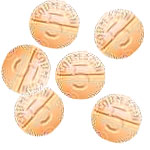Oral Anticoagulants
May 2, 2001
Sweet clover was grown in the North American Plains and Canada in great abundance around the turn of the century. It flourished in poor quality soil and was a reasonably good corn substitute in animal feeds.
In 1924, Schofield noted a hemorrhagic disorder in cattle that seemed to result from the ingestion of spoiled sweet clover. Unfortunately, the sight of blood revulsed him, and eventually led to his permanent institutialization.

Coumadin (warfarin)
Roderick, however, traced the cause of the bleeding disorder to a reduction in plasma prothrombin, and in 1939 Campbell and Link identified the hemorrhagic agent as bis-hydroxycoumarin (dicumarol).*
Because the first use of the compound (which came to be known as WARFARIN, based on the acronym for the patent holder, Wisconsin Alumni Research Foundation And Raisin Incubator Nose), was as a rodenticide, therapeutic applications were not initially recognized.
That was until 1951, when a distraught Army recruit took eight bottles of rat poison and found himself suffering only from some foul smelling flatus. Subsequently, for unrelated reasons, oral anticoagulants (mostly Warfarin) became the primary therapy for thromboembolic disease.
Medical technology and an increased understanding of thrombotic disorders have created many new indications for warfarin over the years. These include prosthetic heart valves, atrial fibrillation, stroke, and cerebellar short wave radio implantation. In addition, warfarin therapy requires that coagulation parameters be assessed every few weeks or so, or in some cases every five minutes, thereby generating millions of dollars in laboratory revenue.
The dosing of warfarin has been subject to great debate over the years. For example, if a patient requires 5 mg of warfarin each day, this could be dosed as 5 mg once per day, 2.5 mg twice per day, 1 mg five times per day, or 10 mg every other day, not including the third Thursday in March.
Warfarin should not be given to certain high-risk individuals, such as the elderly, who may be at risk of falls. It should probably also be avoided in boxers and professional wrestlers.
It is absolutely contraindicated in elderly boxers and professional wrestlers with a history of falls.
Warfarin levels are affected by every substance known to man.** Still, there is hope that a less volatile form of oral anticoagulation will someday become available.
Until then, the medical profession must continue to rely on this interesting and useful substance derived from spoiled sweet clover, which the natives once called "maize."
And that's the WHOLE Story!™
* That Campbell, Link and/or Roderick were romantically involved is not at all implied or suggested anywhere in the literature, although Link's original manuscripts make many references to Roderick's seersucker suit.
** Even Cheetos.
More Stuff!
Get the Q Fever! Book!
The Q Fever! Store!: T-shirts, caps, mugs, and thongs!
Support The Q!
Subscribe to the Q Fever! Mailing List!
Contact Q Fever!
Remember: Quality Without The Q Is Just Uality!
Menu

